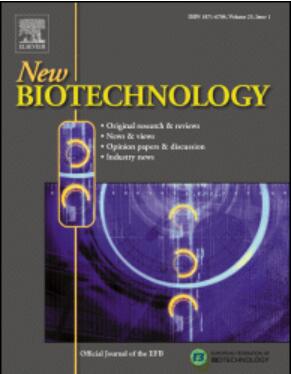Proximity-based site-specific labeling of a native IgG Fab fragment by a fusion microbial transglutaminase-protein G variant
IF 4.9
2区 生物学
Q1 BIOCHEMICAL RESEARCH METHODS
引用次数: 0
Abstract
The fragment antigen-binding (Fab) fragment of IgG has been studied widely as a delivery vehicle for tumor-targeting drugs and dyes due to its high specificity and enhanced tumor penetration, which is attributed to its small size. Functionalizing Fab with chemical entities requires site-specific modification to preserve the binding ninity and ensure product homogeneity. In this study, we report a tag-free, site-specific labeling approach targeting a Lys residue in Fab using the recently developed engineered zymogen of microbial transglutaminase fused with an antibody-binding protein G. Fab of trastuzumab, prepared via papain digestion, was selectively modified at Lys 65 in the heavy chain with a glutamine-donor fluorescent substrate, achieving a high labeling efficiency (∼96 %). Bio-layer interferometry experiments confirmed that the modified Fab retained antigen-binding affinity (KD = 5.71 ± 3.89 nM) comparable to its native counterpart (4.72 ± 3.19 nM). Confocal microscopy analysis demonstrated selective binding of the fluorescent-modified Fab to human epidermal growth factor receptor type2 (HER2)-positive SK-BR-3 cells, with negligible binding to HER2-negative MDA-MB-231 cells. The proposed strategy enables site-specific Fab modification without genetic engineering, offering a streamlined approach to producing homogeneous Fab conjugates for diagnostic imaging and therapeutic antibody engineering applications.
融合微生物转谷氨酰胺酶蛋白G变体对天然IgG Fab片段的邻近位点特异性标记
IgG片段抗原结合(Fab)片段由于其体积小,特异性高,可增强肿瘤穿透性,因此作为肿瘤靶向药物和染料的递送载体被广泛研究。用化学实体功能化Fab需要位点特异性修饰,以保持结合强度并确保产品的均匀性。在这项研究中,我们报道了一种无标签、位点特异性的标记方法,利用最近开发的微生物转谷氨酰胺酶工程酶原与抗体结合蛋白G.融合的Fab中的Lys残基,通过木瓜蛋白酶消化制备曲珠单抗的Fab,在重链中的Lys 65上选择性地修饰谷氨酰胺供体荧光底物,实现了高标记效率(~ 96 %)。生物层干涉实验证实,修饰后的Fab保留了与原物(4.72 ± 3.19 nM)相当的抗原结合亲和力(KD = 5.71 ± 3.89 nM)。共聚焦显微镜分析显示,荧光修饰的Fab与人表皮生长因子受体2型(HER2)阳性的SK-BR-3细胞选择性结合,与HER2阴性的MDA-MB-231细胞的结合可以忽略。所提出的策略使位点特异性Fab修饰无需基因工程,提供了一种简化的方法来生产用于诊断成像和治疗性抗体工程应用的均匀Fab偶联物。
本文章由计算机程序翻译,如有差异,请以英文原文为准。
求助全文
约1分钟内获得全文
求助全文
来源期刊

New biotechnology
生物-生化研究方法
CiteScore
11.40
自引率
1.90%
发文量
77
审稿时长
1 months
期刊介绍:
New Biotechnology is the official journal of the European Federation of Biotechnology (EFB) and is published bimonthly. It covers both the science of biotechnology and its surrounding political, business and financial milieu. The journal publishes peer-reviewed basic research papers, authoritative reviews, feature articles and opinions in all areas of biotechnology. It reflects the full diversity of current biotechnology science, particularly those advances in research and practice that open opportunities for exploitation of knowledge, commercially or otherwise, together with news, discussion and comment on broader issues of general interest and concern. The outlook is fully international.
The scope of the journal includes the research, industrial and commercial aspects of biotechnology, in areas such as: Healthcare and Pharmaceuticals; Food and Agriculture; Biofuels; Genetic Engineering and Molecular Biology; Genomics and Synthetic Biology; Nanotechnology; Environment and Biodiversity; Biocatalysis; Bioremediation; Process engineering.
 求助内容:
求助内容: 应助结果提醒方式:
应助结果提醒方式:


